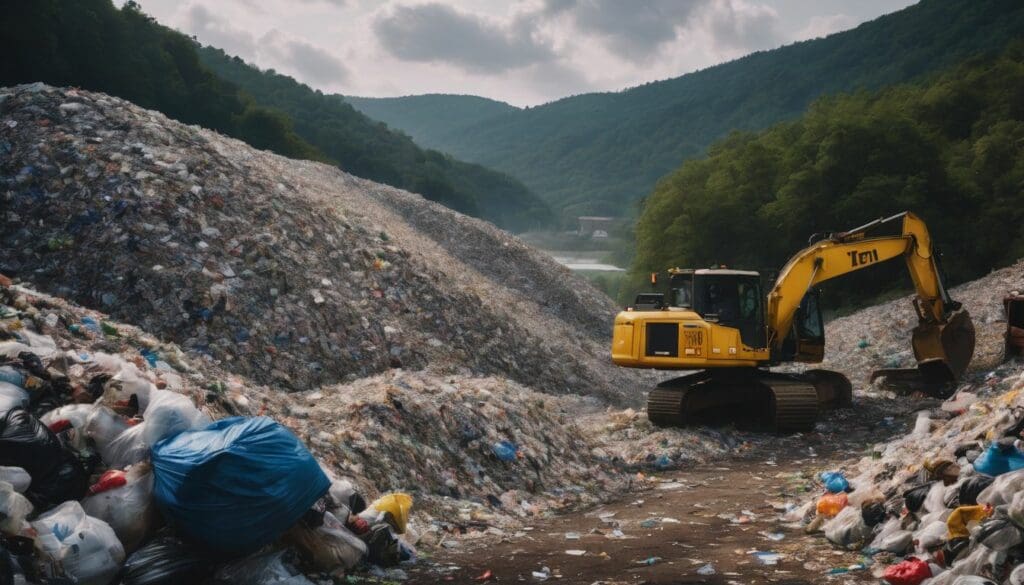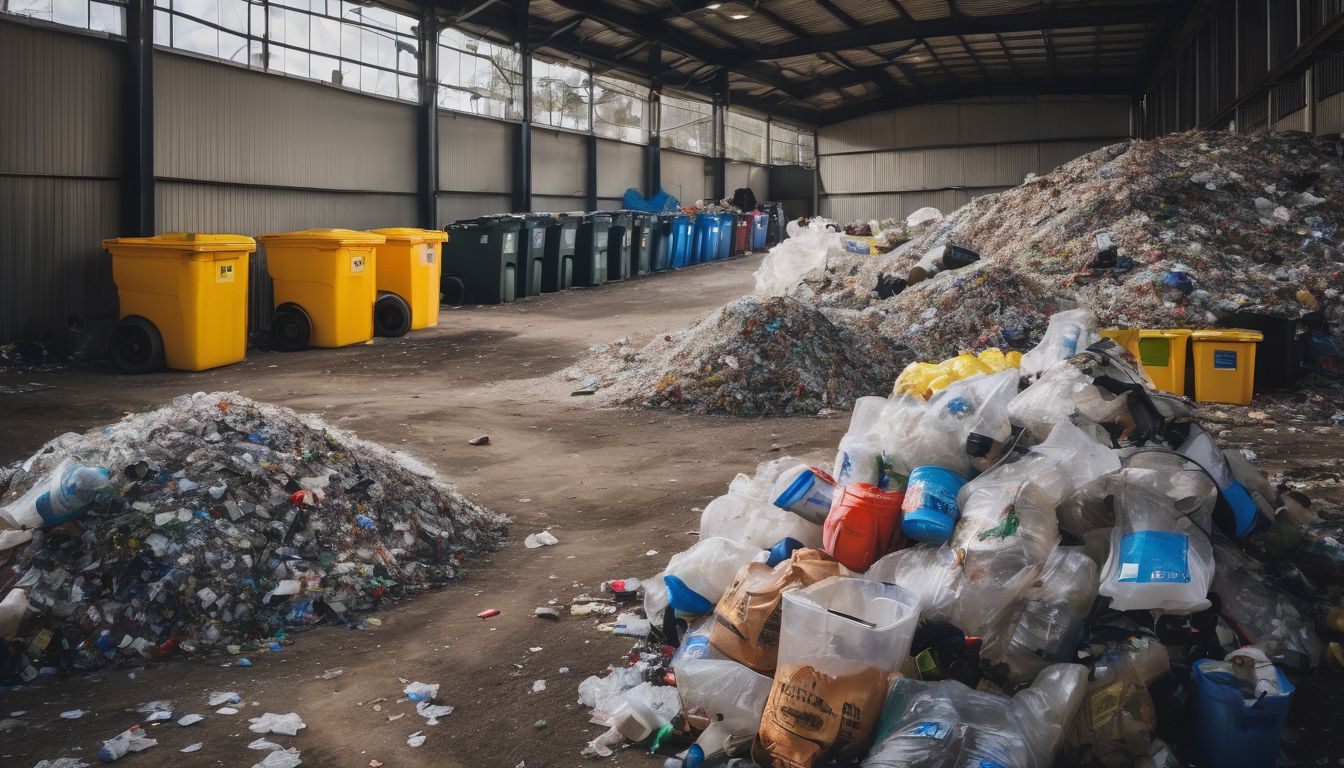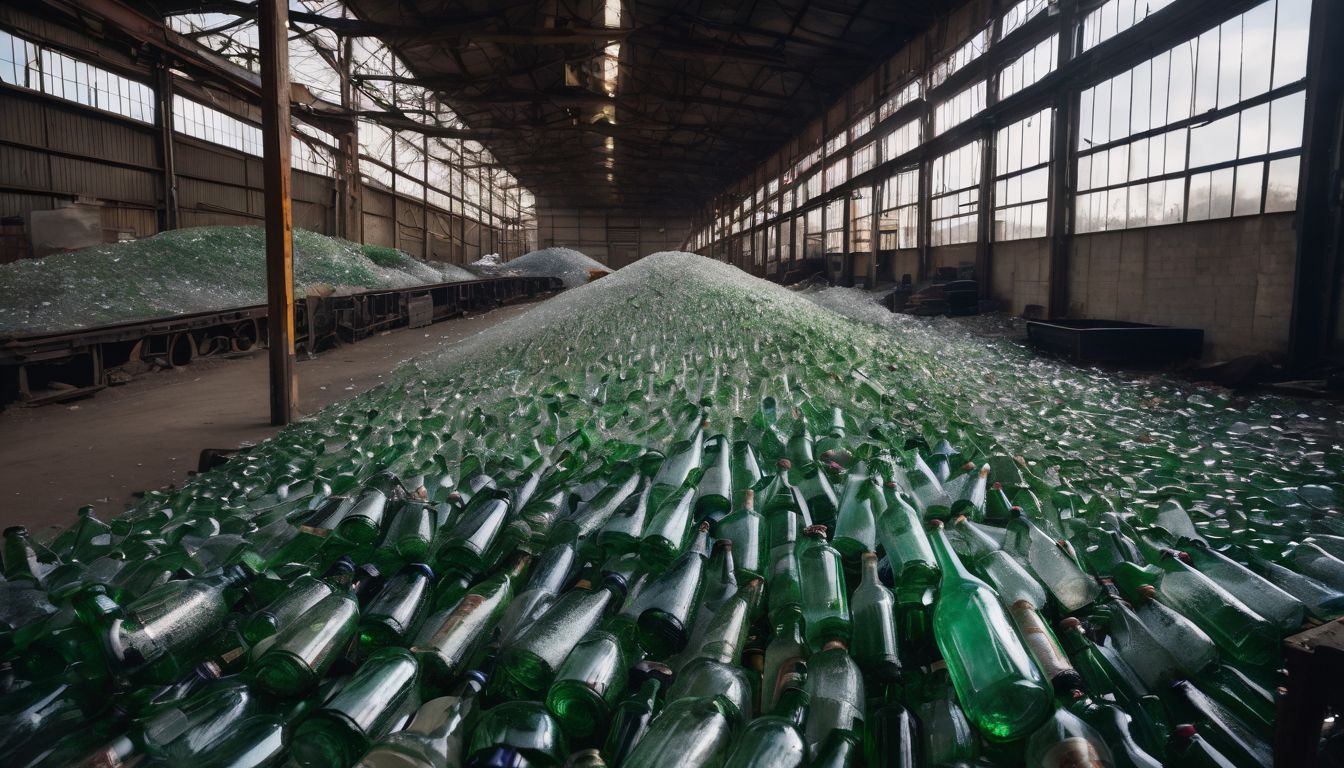The world has changed since COVID-19 hit, and so have our recycling habits. Before the pandemic, global waste recycling rates were already struggling. This blog will explore how the virus has challenged these practices further and spotlight changes we can make together.
Dive in to uncover a greener path ahead!
Key Takeaways
- COVID-19 has disrupted recycling by causing staff shortages and changes in waste generation, with more single-use plastics and cardboard used due to stay-at-home measures.
- Recycling rates have declined during the pandemic as facilities close or reduce services, leading to an increase in landfill use for materials that could be recycled.
- The pandemic has shown that integrated and decentralised waste management can improve efficiency; system thinking is key for sustainability.
- Product design is important for a circular economy; items designed to be durable, reparable, and recyclable reduce waste.
- Policies should focus on managing growing healthcare waste like PPE and maintaining high-quality recycling processes.
Overview of Recycling Practices Before COVID-19
Before COVID-19, the recycling industry faced key challenges in waste management and experienced a decline in recycling rates, particularly in the US. This was due to issues with municipal solid waste infrastructure and limited end markets for recyclable materials.
Key Challenges in Waste Management
Waste management faces a steep challenge from ever-increasing plastic pollution. Our seas and landscapes are littered with bottles, bags, and packaging that threaten wildlife and ecosystems.
Recycling industry struggles to keep pace as the rate of plastic production outstrips recycling efforts. The situation demands innovative solutions to enhance resource conservation and steer us closer to a circular economy.
Another pressing issue is the staggering volume of municipal solid waste heading straight for landfills. Many items that could be recycled or composted are thrown away, squandering valuable materials and energy.
This results in more greenhouse gas emissions which contribute significantly to climate change. Sustained efforts in waste reduction are essential to mitigate environmental impact while promoting sustainability within communities across the globe.
Decline in Recycling Rates
Amidst the key challenges in waste management, the decline in recycling rates has emerged as a significant concern. The COVID-19 pandemic has led to a reduction in recycling activities due to various factors such as limited access to recycling facilities, decreased collection services, and changes in consumer behavior.
This decline has resulted in increased landfilling of recyclable materials like cardboard and plastics, impacting efforts towards sustainability and environmental conservation initiatives.
The pandemic-induced decline in recycling rates has raised awareness about the importance of supporting and revitalising recycling programs. Reversing this trend requires collective efforts from individuals, businesses, and governments to promote responsible waste management practices.
Impact of COVID-19 on Recycling Practices
COVID-19 has disrupted waste infrastructure, leading to changes in waste generation dynamics and shifts in end markets for recycled materials. These changes have had a significant impact on recycling practices worldwide.
Disruption of Waste Infrastructure
The COVID-19 pandemic has disrupted waste infrastructure worldwide, impacting the collection and processing of recyclable materials. This disruption has occurred due to staff shortages, changes in waste generation dynamics, and a shift in consumer behavior towards single-use items.
The closure of recycling facilities and reduced personnel have hindered the sorting and processing of recyclables, leading to a significant backlog of materials awaiting processing.
As a result of the disruptions in waste infrastructure, there has been an increase in landfilling as well as challenges with managing non-recyclable waste streams. Additionally, many regions have experienced temporary suspension or reduction in curbside recycling programs due to resource reallocation efforts during the pandemic.
Changes in Waste Generation Dynamics
The COVID-19 pandemic has significantly altered waste generation dynamics, with an increase in single-use plastic products such as gloves, masks, and packaging contributing to higher levels of plastic waste.
Stay-at-home orders have also led to changes in consumer behavior, resulting in a surge in cardboard and paper waste from online shopping and food delivery services. As people spend more time at home, there is a noticeable rise in household-generated waste.
These shifts highlight the need for greater awareness about responsible consumption and disposal practices. It’s crucial for individuals to adopt sustainable habits by reducing their reliance on single-use items and ensuring proper recycling of materials.
Shifts in End Markets
As a result of the COVID-19 pandemic, there were significant shifts in end markets for recyclable materials. The demand for certain types of plastics used in packaging and medical supplies increased due to healthcare needs, leading to a surge in production and use.
On the other hand, the closure of businesses and public spaces resulted in a decline in demand for recycled cardboard from commercial sources. These fluctuations impacted recycling programs as they had to adapt their processes to address the changing market dynamics.
The pandemic prompted a need for flexibility within recycling systems as they navigated these shifts in end markets. Understanding these changes serves as a crucial factor in adapting waste management strategies while striving towards sustainable solutions.
Opportunities and Lessons Learnt
COVID-19 has presented an opportunity for integrated and decentralised waste management systems, highlighting the importance of system thinking and the role of product design in a circular economy.
This pandemic has taught us valuable lessons about sustainable waste management practices that can shape future policies and guidelines.
Integrated and Decentralised Waste Management
To improve recycling practices, integrated and decentralised waste management systems can be implemented. This approach involves the establishment of smaller-scale waste treatment facilities closer to communities, which can efficiently manage and process recyclable materials.
By integrating these facilities into local communities, it reduces the need for long transportation routes and allows for better sorting and processing of materials at a grassroots level.
Implementing integrated and decentralised waste management not only improves recycling rates but also promotes community involvement in sustainable waste practices. It empowers individuals to take an active role in managing their own waste while contributing to broader environmental conservation efforts.
Importance of System Thinking
System thinking is vital for creating sustainable waste management solutions. It involves considering the interconnectedness of various processes and elements within the recycling system.
By adopting a systemic approach, we can better understand how changes in one part of the system impact others, leading to more holistic and effective strategies for managing waste.
This means taking into account not only individual components like collection and processing but also broader factors such as consumer behavior, market dynamics, and policy frameworks.
Applying system thinking allows us to identify leverage points where interventions can have the most significant positive impact on recycling practices. It encourages a shift towards long-term solutions that address root causes rather than just treating symptoms.
Role of Product Design in Circular Economy
Product design plays a crucial role in transitioning towards a circular economy. When products are designed with durability, reparability, and recyclability in mind, they contribute to reducing waste and conserving resources.
Additionally, incorporating sustainable materials and production processes can minimise environmental impact throughout the product’s lifecycle. Remanufacturing and refurbishing practices also extend the usability of products, promoting a more sustainable consumption pattern.
Furthermore, designing products for disassembly facilitates material recovery at the end of their life cycle. This approach aligns with circular economy principles by enabling components and materials to be reused or recycled effectively.
Considering these aspects during product design encourages an eco-friendly mindset while spurring innovation for greener solutions.
Implications for Policy and Guidelines
Policy and guidelines need to address the management of healthcare waste and emphasise the importance of both quantity and quality of waste.
For more insights on the impact of COVID-19 on recycling practices, keep reading!
Healthcare Waste Management
COVID-19 has led to significant changes in healthcare waste management, with increased disposal of personal protective equipment (PPE) and medical supplies. Facilities have faced challenges in safely managing and properly disposing of infectious waste, as well as maintaining recycling practices for non-hazardous materials.
- Increased Generation of PPE Waste: The pandemic has resulted in a surge in the use of single-use PPE such as masks, gloves, and gowns, leading to a substantial increase in medical waste generation.
- Strain on Recycling Infrastructure: Healthcare facilities have faced constraints in segregating and recycling non-infectious waste due to heightened focus on infection control measures, resulting in a strain on existing recycling infrastructure.
- Need for Specialised Disposal Measures: Proper disposal methods are critical for infectious medical waste, encouraging the need for stringent guidelines and specialised treatment facilities to ensure safe management.
- Importance of Sustainable PPE Options: Emphasis is being placed on developing eco-friendly and biodegradable PPE alternatives to reduce the environmental impact associated with widespread PPE consumption.
- Advocacy for Circular Economy Practices: Promoting the adoption of circular economy principles within healthcare settings can facilitate efficient resource utilisation while minimising waste generation through innovative product design and material sourcing strategies.
- Role of Community Engagement: Encouraging community involvement in sustainable healthcare waste management is vital, fostering awareness around responsible disposal practices and supporting initiatives towards green healthcare facilities.
Importance of Quantity and Quality of Waste
Ensuring the quantity and quality of waste is crucial for effective recycling initiatives. The amount of recyclable materials collected directly impacts the success of recycling programmes, making it essential to increase collection rates.
Simultaneously, maintaining the quality of waste ensures that the recycled materials meet market standards, supporting sustainable end markets and closing the loop in a circular economy.
Balancing quantity and quality of waste optimises resources and supports environmentally friendly practices. Maximising collection efficiency while also preserving material integrity enriches the viability and impact of recycling efforts, fostering a more sustainable future.
Conclusion
In conclusion, the COVID-19 pandemic has significantly impacted recycling practices. The disruption of waste infrastructure and changes in waste generation dynamics have posed challenges.
However, it also presents opportunities to implement integrated and decentralised waste management systems. Moving forward, a system thinking approach and a focus on product design in the circular economy will be crucial for advancing recycling practices post-pandemic.
FAQs
1. How has COVID-19 affected recycling programs in the US?
COVID-19 has impacted recycling practices, causing some disruptions in US recycling programs due to safety concerns and changes in waste streams like increased cardboard use.
2. What happened with cardboard recycling during the pandemic?
With more people shopping online due to COVID-19, there was a surge in cardboard usage, putting pressure on recycling systems to manage the higher volumes of material.
3. Has PPE waste been a problem for US recycling efforts?
Yes, personal protective equipment (PPE) waste management became challenging for US recycling centers as they had to handle an influx of potentially contaminated items which often aren’t recyclable.
4. Are there any green initiatives that address these new challenges from COVID-19?
Green initiatives are adapting by focusing on sustainable PPE options and enhancing the capacity of existing programs to better cope with the additional waste from pandemic-related products.





